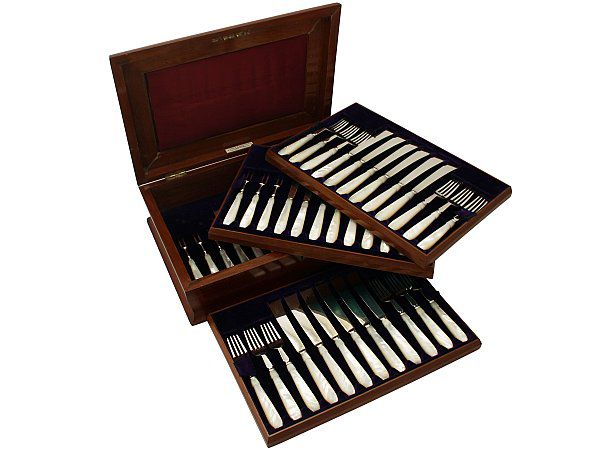Ice cream, molten chocolate cake, cheesecake, chocolate eclairs, jelly, apple pie, fruit…the list goes on and on. I’m sure we’ve all got our favourite type of dessert. But the question is, do we really know how to eat them properly? Do we know our dessert etiquette?
We need to rectify this situation if we want to keep eating dessert, and I don’t know about you, but not eating dessert in any setting is never going to stop happening for me. So, let’s begin… dessert etiquette 101.
Dessert Cutlery
Dessert cutlery usually involves a dessert fork, dessert spoon and occasionally a dessert knife. At formal and informal affairs dessert cutlery is placed differently, and trickily restaurants can have different ways of placing dessert cutlery. I will quickly give you the low-down to make sure you are prepared for every eventuality.
If you are in a restaurant, you may be served dessert cutlery with your chosen dessert, or they may already be present on the table. If the latter is the case then they will usually be located at the top of your plate. When dessert is served, slide them down to the side of your plate, spoon on the right, fork on the left. The fork should always go on the left, even if the spoon has been changed for a knife.
At a formal event, dessert cutlery is laid out like so; dessert fork on the left of the plate, spoon or knife on the right. At an informal event, the dessert cutlery can be laid on the table or presented on the dessert plate or bowl. Similar to a restaurant setting, at an informal event the dessert spoon or knife can be found at the top of the plate, lying horizontally, handle facing the right, the dessert fork is laid beneath the dessert spoon or knife, facing the other way.
As you can probably tell, at an informal or formal event or in a restaurant setting the dessert cutlery is not a difficult thing to master. They will either be presented to you with dessert or will already be on the table. Just remember fork on the left, spoon or knife on the right before you tuck into your delicious treat.
Let’s get stuck in

I would suggest the general go-to, if you have been presented with a dessert fork and a dessert spoon, is to break your dessert with your spoon, push the food with the fork onto the spoon and then eat from the spoon. Note, fork should be in your left hand and spoon should be in your right.
Now with different desserts there is a different procedure. Texture is key! Soft desserts- spoon. Firm- spoon and fork. Layered- fork.
When eating a soft dessert, use a spoon and use your fork for garnishes such as berries. Pie, cake, pastries; any dessert served with ice cream can be eaten with either or both a dessert fork and spoon.
This one is quite specific, but seeing as it is quite a popular dessert option it’s well worth delving into…the layer cake. Sometimes you may be served the layer cake with the slice standing upright, you should turn it on its side using your dessert cutlery, then precede to eat it using your dessert fork.
For firm desserts such as poached fruit or dense cakes it is imperative to switch your dessert cutlery; use your dessert fork for eating and your dessert spoon for cutting and pushing.
Cake with a crumbly, dry texture should be broken into small pieces and eaten a bite at a time. Cake with a gooey, moist texture should be eaten with a fork. Now an ice cream cake, being both moist and dry should be eaten with a fork and a spoon. The fork is used to hold the portion and the spoon to cut and bring to your mouth.
Another popular dessert- pie. If you are having pie, be careful, it is firm (crust) and can be soft (filling), so doesn’t directly fall into any of our categories so far. Therefore, it is my duty to let you know that pie should be eaten with your dessert fork, with the help of your dessert spoon if your crust is difficult to cut with your fork alone.
o, there we have it…dessert etiquette 101. Now I’m not sure about you, but I’m feeling kind of peckish!







4 responses
Hello Rachel,
Thank you so much for this advice. I teach social and dining etiquette to children and adults, and have often wondered when one oneness allowed to put the dessert fork in one’s mouth. My four year old business is “Confidence with Etiquette “. I’ve been living and teaching in the USA for 20 years.
Many thanks for your comment, that sounds a fabulous job Sarah.
Hi Rachel,
I cannot tell you how helpful this article has been. I have just started to collect antique/vintage cutlery and presented with the opportunity to purchase dessert knives, forks and spoons I jumped in with both feet. I even managed to to obtain a few of those curious pie forks with the one wide and two narrow tines! The one question your article didn’t answer is: for what type of dessert would one be presented with a dessert knife? My first thought was for fruit but the pattern I am collecting also has fruit knives. Any guidance you can provide would be much appreciated.
Hi Christine, thank you for your comment. You are correct in a assuming a dessert knife would be used for fruit. However, as you mentioned you already have fruit knives I will speak to one of my colleagues and try and get some further information for you.